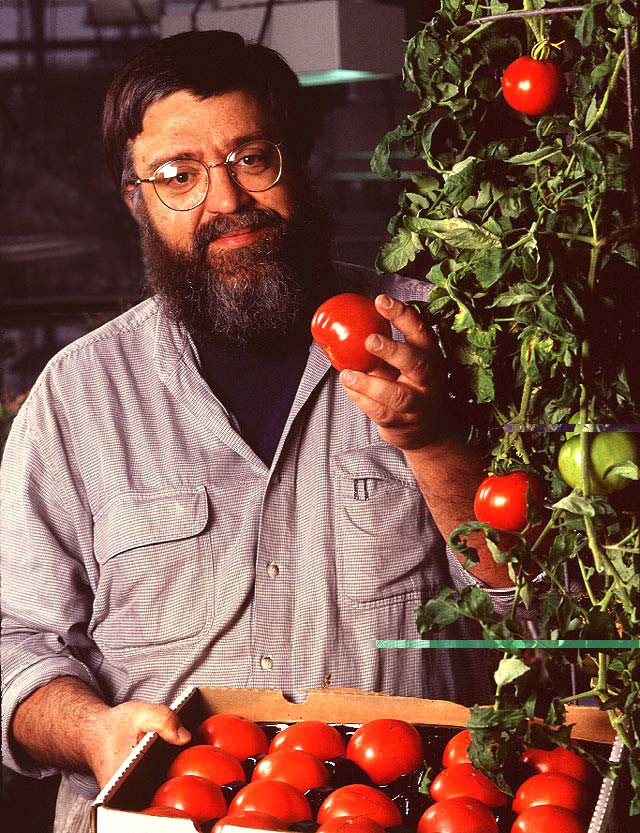“Fish tomatoes,” are transgenic tomatoes that have been genetically engineered with a gene from winter flounder, which are also known as lemon sole. Fish tomatoes have become an icon in the debate over Genetically Modified Foods, especially in relation to the perceived ethical dilemma of combining genes from different species. So, what, exactly, are genetically modified foods? The following commentary is from the Human Genome Project Information web page developed and coordinated by the U.S. Department of Energy and the National Institutes of Health:
Although “biotechnology” and “genetic modification” commonly are used interchangeably, GM is a special set of technologies that alter the genetic makeup of organisms such as animals, plants, or bacteria. Biotechnology, a more general term, refers to using organisms or their components, such as enzymes, to make products that include wine, cheese, beer, and yogurt. Combining genes from different organisms is known as recombinant DNA technology, and the resulting organism is said to be “genetically modified,” “genetically engineered,” or “transgenic.” GM products (current or those in development) include medicines and vaccines, foods and food ingredients, feeds, and fibers. Locating genes for important traits—such as those conferring insect resistance or desired nutrients—is one of the most limiting steps in the process. However, genome sequencing and discovery programs for hundreds of organisms are generating detailed maps along with data-analyzing technologies to understand and use them.
In 2006, 252 million acres of transgenic crops were planted in 22 countries by 10.3 million farmers. The majority of these crops were herbicide- and insect-resistant soybeans, corn, cotton, canola, and alfalfa. Other crops grown commercially or field-tested are a sweet potato resistant to a virus that could decimate most of the African harvest, rice with increased iron and vitamins that may alleviate chronic malnutrition in Asian countries, and a variety of plants able to survive weather extremes. On the horizon are bananas that produce human vaccines against infectious diseases such as hepatitis B; fish that mature more quickly; cows that are resistant to bovine spongiform encephalopathy (mad cow disease); fruit and nut trees that yield years earlier, and plants that produce new plastics with unique properties.
In 2006, countries that grew 97% of the global transgenic crops were the United States (53%), Argentina (17%), Brazil (11%), Canada (6%), India (4%), China (3%), Paraguay (2%) and South Africa (1%). Although growth is expected to plateau in industrialized nations, it is increasing in developing countries. The next decade will see exponential progress in GM product development as researchers gain increasing and unprecedented access to genomic resources that are applicable to organisms beyond the scope of individual projects.
Technologies for genetically modifying foods offer dramatic promise for meeting some of the 21st Century’s greatest challenges. Like all new technologies, they also pose some risks, both known and unknown. Controversies surrounding GM foods and crops commonly focus on human and environmental safety, labeling and consumer choice, intellectual property rights, ethics, food security, poverty reduction, and environmental conservation.
Benefits:
- Crops: Enhanced taste and quality; reduced maturation time; increased nutrients, yields, and stress tolerance; improved resistance to disease, pests, and herbicides; new products and growing techniques
- Animals: Increased resistance, productivity, hardiness, and feed efficiency; better yields of meat, eggs, and milk; improved animal health and diagnostic methods
- Environment: “Friendly” bioherbicides and bioinsecticides; conservation of soil, water, and energy; bioprocessing for forestry products; better natural waste management; more efficient processing
- Society: Increased food security for growing populations
Controversies:
- Safety: Potential human health impacts, including allergens, transfer of antibiotic resistance markers, unknown effects; potential environmental impacts, including: unintended transfer of transgenes through cross-pollination, unknown effects on other organisms (e.g., soil microbes), and loss of flora and fauna biodiversity
- Access and Intellectual Property: Domination of world food production by a few companies; increasing dependence on industrialized nations by developing countries; biopiracy, or foreign exploitation of natural resources
- Ethics: Violation of natural organisms’ intrinsic values; tampering with nature by mixing genes among species; objections to consuming animal genes in plants and vice versa; stress for animals
- Labeling: Not mandatory in some countries (e.g., United States); mixing GM crops with non-GM products confounds labeling attempts
- Society: New advances may be skewed to interests of rich countries





